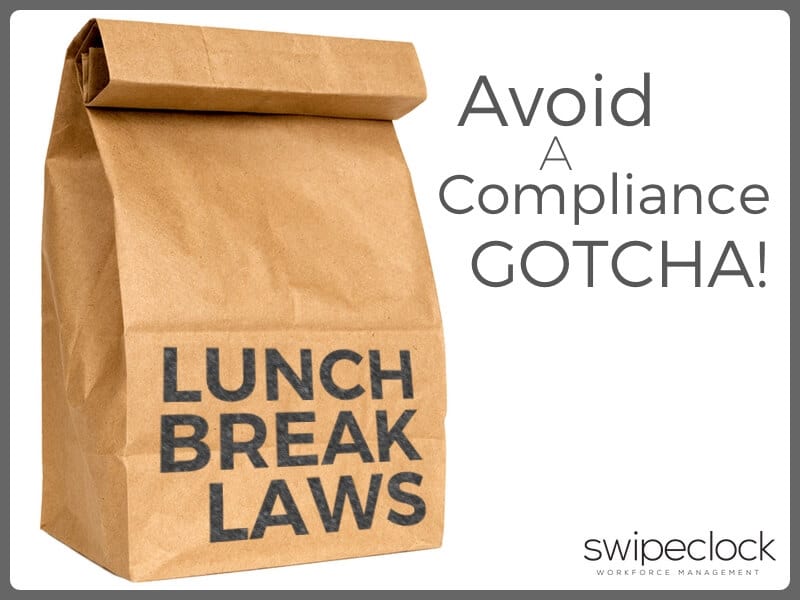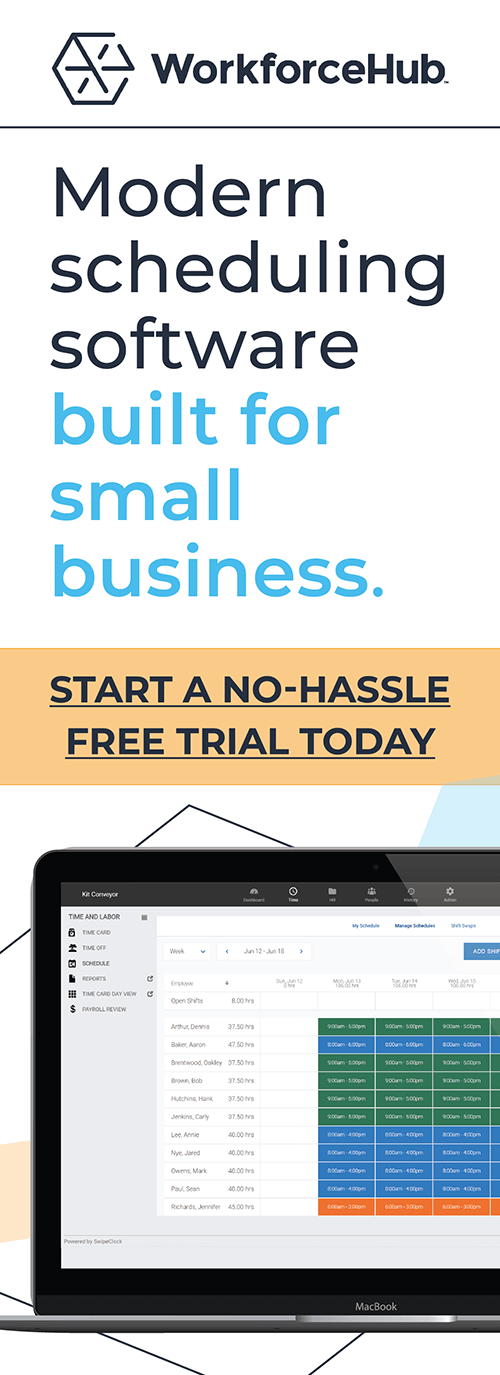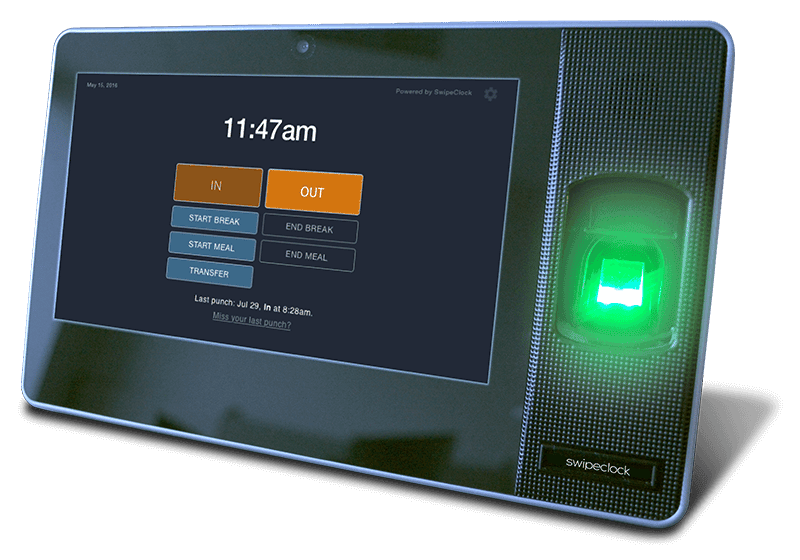Lunch Break Laws: Avoid a Compliance Gotcha

Why Should I Worry About Lunch Break Laws?
How did something simple get so complicated? Your employees come to work. They take a mid-morning break. They clock out for lunch. They take a mid-afternoon break. What’s the problem? Well, there are many potential problems. You could be breaking a State or Federal law—that’s probably the scariest. You could also be paying more in payroll than you need to. And you may not understand what’s going on at your company when it comes to breaks. Before we explore further, let’s define what we are talking about. There are many types of breaks in addition to lunch breaks.
Types of Employee Breaks
A break is a period of time during work hours in which an employee is allowed to stop performing their job duties. There are several different types of breaks. They vary in length and may or may not require the employee to clock out. When an hourly employee is required to clock out, it is called an unpaid break. If an employee is allowed to remain clocked in during a break, it is called a paid break. Following are the most common types of breaks.
Coffee Break or Smoke Break
These are colloquial terms with no standard definitions in US employment law. However, they are common in workplaces around the world. In Britain, for example, the cherished “tea break” is an honored tradition. An employer who allows, “smoke breaks” should be aware of potential resentment. If the smokers are allowed more breaks than the non-smokers, the non-smokers can feel (understandably) slighted. To avoid this, some employers give all workers equal break time—whether or not they smoke.
Meal Break or Lunch Break
A meal break is generally longer than a short break. Most US employers allow hourly workers to take a lunch or dinner break from 30 minutes to an hour. Most salaried workers are also allowed to take a meal break from 30 to 60 minutes. Remember that an employee must be able to discontinue all work duties during a lunch break. Otherwise, the employer must pay the employee for the time. For example, a customer service rep that must take calls while eating a sandwich at her desk. In these situations, the employer must pay the employee for the time—even if she only takes one short call.
Nursing Mother Break
The Fair Labor Standards Act (FLSA) was amended in 2010 to include a Break Time for Nursing Mothers provision. Employers must provide “reasonable” break time to express milk for an infant for one year after the child’s birth. The law does not specify how many breaks per shift or how long the break must be. Note that employers must also provide a private area (other than a bathroom) for the employee to express milk.
Bathroom Breaks
We’ve all heard horror stories of abusive employers who prevent production line employees from going to the bathroom. Bathroom breaks are codified in the Occupation Safety and Health Administration (OSHA) provisions. The law prevents employers from restricting bathroom breaks or requiring employees to follow a schedule. Make sure you let your employees go when they need to. Moving on…
On-Call Time
On-call time is time when the employee is not working, but must be available to begin performing work duties upon request. Legal precedent has established two types of on-call work: “An employee who is required to remain on call on the employer’s premises or so close thereto that he cannot use the time effectively for his own purposes is working while “on call.” An employee who is not required to remain on the employer’s premises but is merely required to leave word at his home or with company officials where he may be reached is not working while on call.” (Armour & Co. v. Wantock, 323 U.S. 126 (1944); Handler v. Thrasher, 191 F. 2d 120 (C.A. 10, 1951); Walling v. Bank of Waynesboro, Georgia, 61 F. Supp. 384 (S.D. Ga. 1945))
Sleep Time
Many employees who work shifts longer than 24 hours are due sleep time. You can read more about sleep breaks here: Department of Labor Break Compliance.
Health Issues
The American with Disabilities Act (ADA) addresses breaks for employees with health issues. The ADA requires employers to allow “reasonable accommodation” for conditions that require an employee to leave work duties.
International Lunch Break Laws
Employers who open a division outside of the US consider labor laws when performing due diligence. Workplace regulations and the associated costs vary considerably from country to country. If you are feeling unduly regulated, check out employee protections in Norway or the Netherlands.
Federal Labor Laws That Govern Lunch Breaks
The Federal Labor Standards Act (FLSA) does not require employers to provide meal, smoking, or coffee breaks. When business owners do allow short breaks, however, they should pay the employee for the time. The FLSA defines a “short” break as between 5 and 10 minutes. Many employers with hourly workers allow a short break mid-morning and mid-afternoon during an 8-hour shift. Some employers grant part-time workers breaks based on the length of shift.
State Laws That Govern Lunch Breaks
Many states have their own lunch break laws. Note that these generally have a higher (or different) standard than the FLSA provisions. To see lunch break laws by state: Minimum Breaks for Meals by State.
Use Workforce Management for Lunch Break Laws
Now we have looked at the most common types of breaks. How do you make sure you are complying with lunch break laws? The easiest way is to turn the task over to a smart Workforce Management system with a lunch break tracking tool.
TimeWorksPlus Tracks Lunch Breaks
TimeWorksPlus from SwipeClock takes the hassle out of employee lunch break compliance. With TimeWorksPlus, you can automate compliance with any state’s lunch break laws. Our “intelligent clock” prompts employees for paid and unpaid breaks of all types.
TimeWorksPlus Meal Compliance
With TimeWorksPlus, employers set compliance rules based on Federal law, State law, and company policies. You can choose if an employee is paid back their meal period and the applicable rate. Regulate how long lunch breaks are allowed for different classes of employees. Configure for specific industry provisions.
Save Money
TimeWorksPlus enforces employee lunch break policies so you don’t pay employees for unpaid lunch breaks. It restricts employees from punching out too late for an unpaid break or punching in too early following the break.
Comply With Overtime Laws
Paid breaks have implications for workers who are subject to overtime protections. (These are sometimes called non-exempt employees). The time an employee spends taking short breaks counts toward total weekly hours for overtime calculation. Meal breaks—generally lasting 30 minutes or more—may be unpaid. In other words, employers may require workers to clock out during meal breaks. As such, unpaid meal breaks do not count toward total hours for overtime requirements.
Prevent Lunch Break Abuses
If you are not required by State law to provide paid lunch breaks, make sure your employees aren’t on the clock. TimeWorksPlus can automatically deduct lunch breaks even if an employee doesn’t clock out.
Set Meal Durations for State Lunch Break Laws
Do you want to prevent employees from clocking in early from a lunch break? TimeWorksPlus can be set for any State-defined lunch break duration you require. TimeWorksPlus is the time and attendance tracking tool in SwipeClock’s Workforce Management Suite. For more information, see Lunch Break Tracking. By Liz Strikwerda
Simplify HR management today.
Simplify HR management today.
Employee Time Clock Hardware: Which is the Best?
Updated April 9, 2024 What is employee time clock hardware? An employee time clock is a hardware device for tracking work time. To use it, employees ‘punch’ in/out or ‘clock’ in/out. The term ‘punch in’ stems from early employee time clock hardware that required a physical card. With a traditional mechanical time clock, the process…
Read MoreAre Remote Workers More or Less Productive?
Remote work grew substantially in 2020 and the subsequent years, with more than 27 million people reporting working from home between 2019 and 2021. This number marks an increase of over three times how many people worked remotely before the COVID-19 pandemic sent people home and restricted who could perform in-person work. But as company…
Read More





